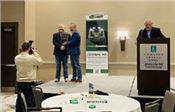Conservation Conferences Honored Barber As Soybean Researcher Of The Year

Extension Weed Scientist Tom Barber receives a plaque as the Conservation Conferences soybean researcher of the year.
Taken Feb. 1. U of A System Division of Agriculture photo by Whitney Haigwood
MARY HIGHTOWER
JONESBORO, ARKANSAS
If not for a text from a colleague, Tom Barber might not have been on hand to receive his honor as Soybean Researcher of the Year from the Conservation Systems Conferences.
Barber, an extension weed scientist for the University of Arkansas System Division of Agriculture, received the research award on Tuesday.
Turns out the conference organizers have a great talent for keeping a secret.
The first months of the year are a whirlwind for Barber and fellow extension colleagues, who spend more time on the road speaking at county winter production meetings than they do at home. Barber, who was scheduled to speak at the conference in Jonesboro, was just trying to juggle events in a very crowded schedule when he planned to arrive just in time for his talk.
At least that was the plan until he heard from Jeremy Ross, extension soybean agronomist.
“Jeremy sent me a picture of me in the program, talking about me getting an award,” Barber said. “I had no idea. If he hadn’t told me I wouldn’t have been there to pick it up.”
It’s the second time Barber has been honored at this event. In 2010, he was honored as the cotton researcher of the year.
“I didn’t know I’d won it that year either,” Barber said with a laugh.
“I’m humbled by this award. I feel blessed to have a great crew that works with me,” he said. “This is a direct result of their work and ability to get things done and their work ethic.”
Barber has been attending this meeting since 2005.
“It is one of my favorite meetings every year,” he said. “There is always a great turnout of farmers, consultants, industry cooperators and colleagues from all Mid-South states. Especially considering most meetings were virtual last year, it has been great to see and visit with everyone in person.”
A large portion of Barber’s applied research in soybean revolves around managing pigweed.
“We discovered PPO resistance several years ago and have been working on way to manage that in soybean,” he said. “And now we’ve identified glufosinate and dicamba resistance in some pigweed populations from northeast Arkansas which will be a main focus for the program moving forward.
“In the last three years, we’ve been fortunate to work with several new technologies, one of which is the Redekop Seed Destructor as a means to destroy pigweed escapes at harvest and prevent future generations,” Barber said. “The Redekop seed destructor will be a game changer in the fight against resistant pigweed.”
Bob Scott, who worked alongside Barber as a weed scientist before becoming director of the Cooperative Extension Service, wrote the nomination.
"It is good to see Dr. Barber get recognition for his work in soybean," Scott said. "Although he is more known as a cotton guy, he has worked very hard on issues over the year in soybean as well."
Vic Ford, associate director – agriculture and natural resources for the Cooperative Extension Service, called Barber "a leader in his research and extension programs.
"He is not an overnight success but a product of hard work and long hours to discover and disseminate timely results to Arkansas farmers," Ford said. "Faculty like Tom support their support staff and program from grants and gifts. Dr. Barber’s program is one of the top in the country and that support demonstrates the value of the program."
The 25th annual Conservation Systems Conferences was held at the Embassy Suites by Hilton Red Wolf Convention Center in Jonesboro. The event had 100-plus presentations, including more than a dozen from research and extension personnel with the University of Arkansas System Division of Agriculture.
The Division of Agriculture was among the conferences’ seven academic co-sponsors. ∆